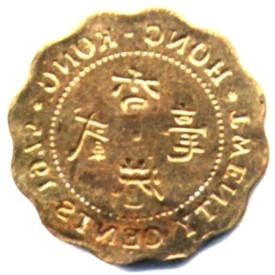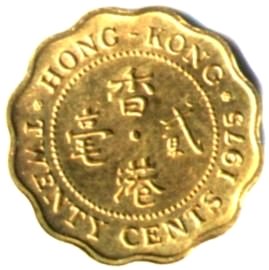



Hong Kong 1975 Twenty Cents
Full Brockage Strike of Reverse
At times, due to a malfunction of components of a minting press, a previously struck coin may fail to be ejected from the collar die by the lower die or by the planchet feeder finger when the lower die raises the struck coin above the top of the collar die. In such cases, the struck coin will remain in the collar when the next planchet is fed into the collar for striking. After the strike, the second coin (ie. the aforementioned "next planchet") will display the normal design imparted by the top die (reverse) and an incuse (mirror image) design imparted by the top of the previously struck coin resting below. If the previously struck coin has not flipped over, it will impart an incuse image of the reverse. The incuse image will always be very slightly expanded because the planchet metal is softer than the steel of the dies. In turn, the image on the side of the coin that imparted the incuse design will be very slightly flattened and distorted. Both the second (on the reverse) and first (on the obverse) coins will show either a high wire rim or stronger (fuller) than normal rim (details) due to the extra pressure exerted in the coining chamber (collar) from the presence of two planchets. The coin with the incuse image is termed a brockage. If the brockage is of the reverse design, the error is called a reverse brockage. If the brockage is of the obverse design the error is called an obverse brockage. There are other brockage type errors which occur, but in the case where the brockage is created within the coining chamber and results in a complete design transer, the word "full" is used in the description.
{Thanks to Mr. Robert Kril for providing the descriptions}
Click Here to See Other Error Coins ..Click Here to See Other Hong Kong Coins
Click Here to See Other Hong Kong Coins
Click Here to Go Back to Homepage
¡@